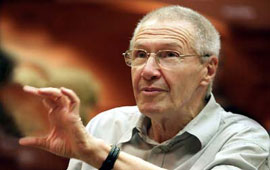> [Archived] Interviews

Interviu with Constantin Tufan-Stan
How did you come up with the idea of writing a book about György
Kurtag's life?
I felt the strongest impulse when I realized I was contemporary of
such a great and internationally important musician. Being from the
same town as maestro Kurtag, I analyzed some biographical details
and I discovered interesting things about his training period in Lugoj,
his first contacts with the musical life and where he started his
musical studies in piano and composition.
Your book is entitled György Kurtag, Returning to the Spiritual
Matrix. Could you explain us the title, in relationship to the book?
Since the moment I contacted maestro Kurtag, with the intention to
know him better, I managed to make him get closer to his spiritual
womb, Lugoj, Timisoara, Banat, the Romanian culture in general. The
maestro thus returned to the Romanian spirituality and literature,
and composed an important work, Ballad-Carols, as a tribute to our
professor, Felician Brânzeu. He used for the first time the text of
a carol found by Béla Bartók in 1913 in Paucinesti - Hunedoara. Starting
from this reality, I considered that this title was very appropriate
for the book, as we witness, indeed, a returning of György Kurtag
to his spiritual matrix.
Could you give us a few 'technical' details about the volume whose
author you are?
The book was first launched in Cluj and it has a foreword by maestro Francisc Laszlo. The second launch took place on the occasion of the concert which the Banatul Philharmonic in Timisoara dedicated to maestro Kurtag on 16th October. On this occasion, the instrumental performers from Timisoara also played one of the maestro's works - the ballad for viola and orchestra. It isn't a large volume, it has about 100 pages. It is an introduction to the maestro's biography, with some analytical studies, but the theme of the book in general is his biography. It is illustrated with images which I took when visiting the maestro last year, in Lugoj, after many decades.
Translated by Alina Roxana Chirila
MA Student, MTTLC, Bucharest University














